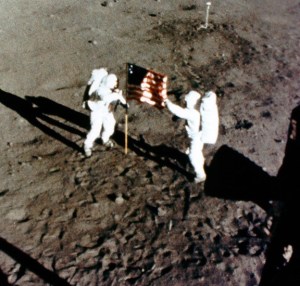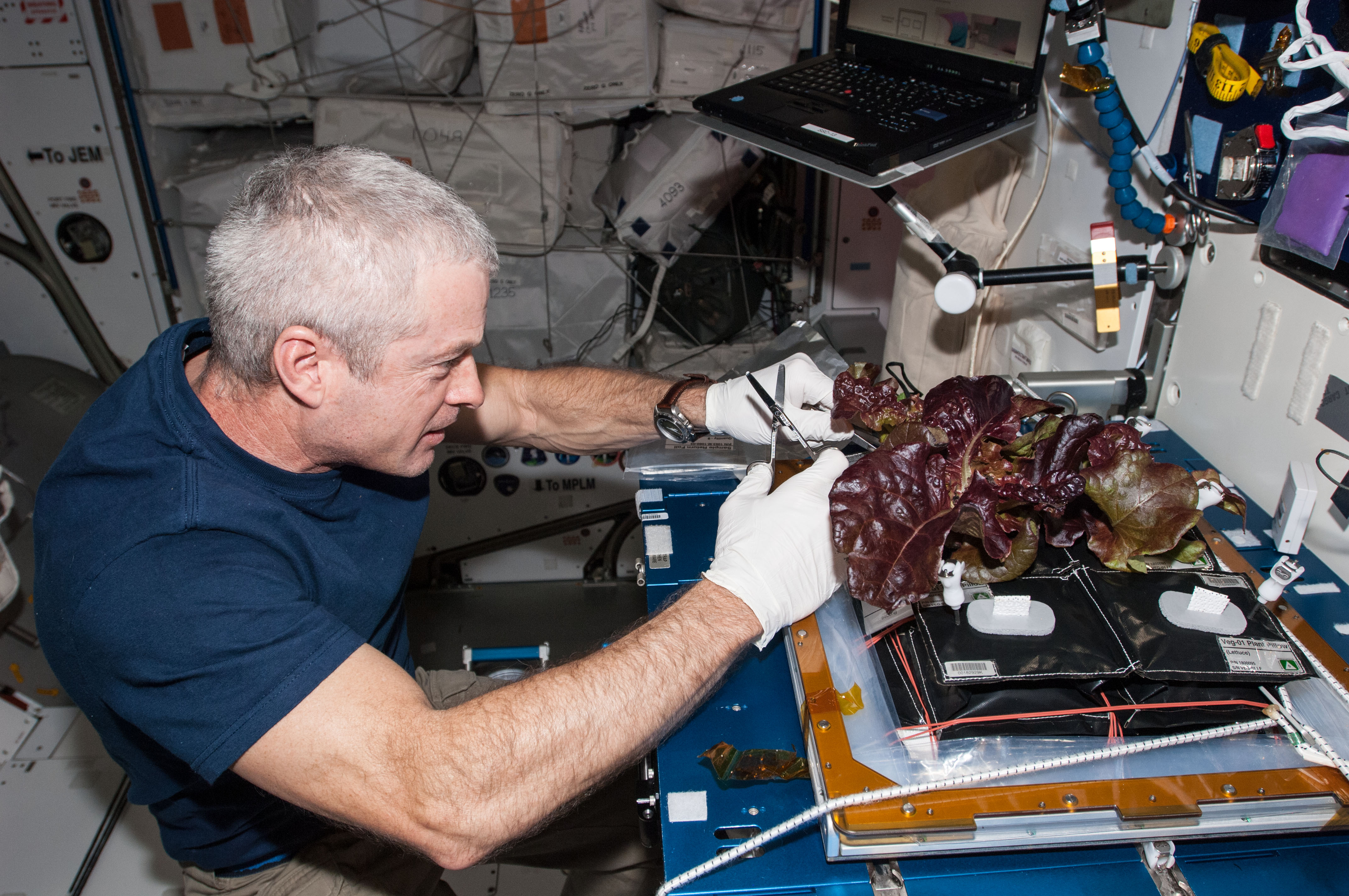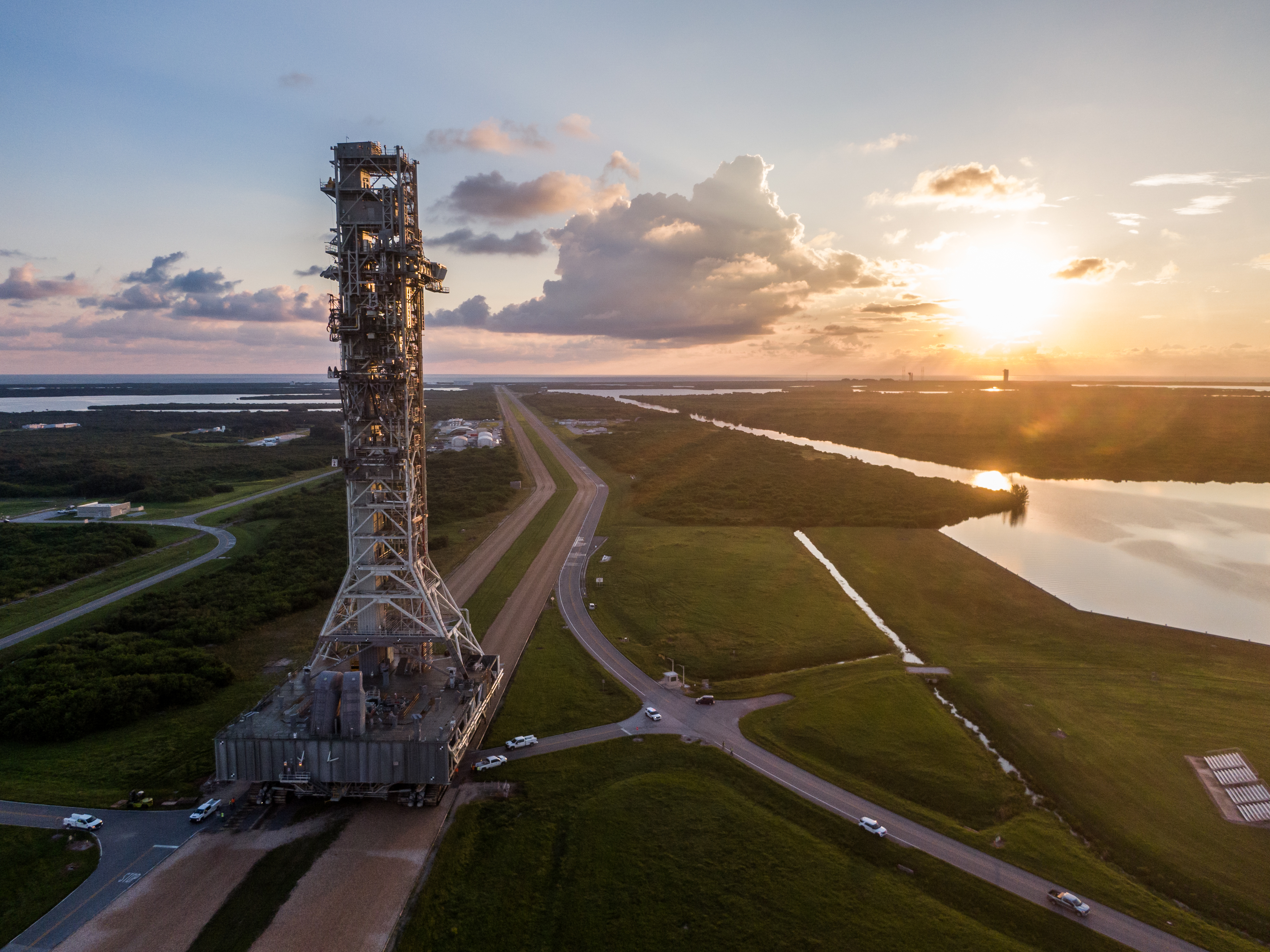45 Years Ago: Space Shuttle Enterprise Completes Launch Pad Checkout
On July 23, 1979, space shuttle Enterprise completed its time as a pathfinder vehicle at Launch Pad 39A at NASA’s Kennedy Space Center (KSC) in Florida. Workers towed it back to the Vehicle Assembly Building (VAB). During its four-month stay at KSC, Enterprise validated procedures for the assembly of the space shuttle stack and interfaces […]
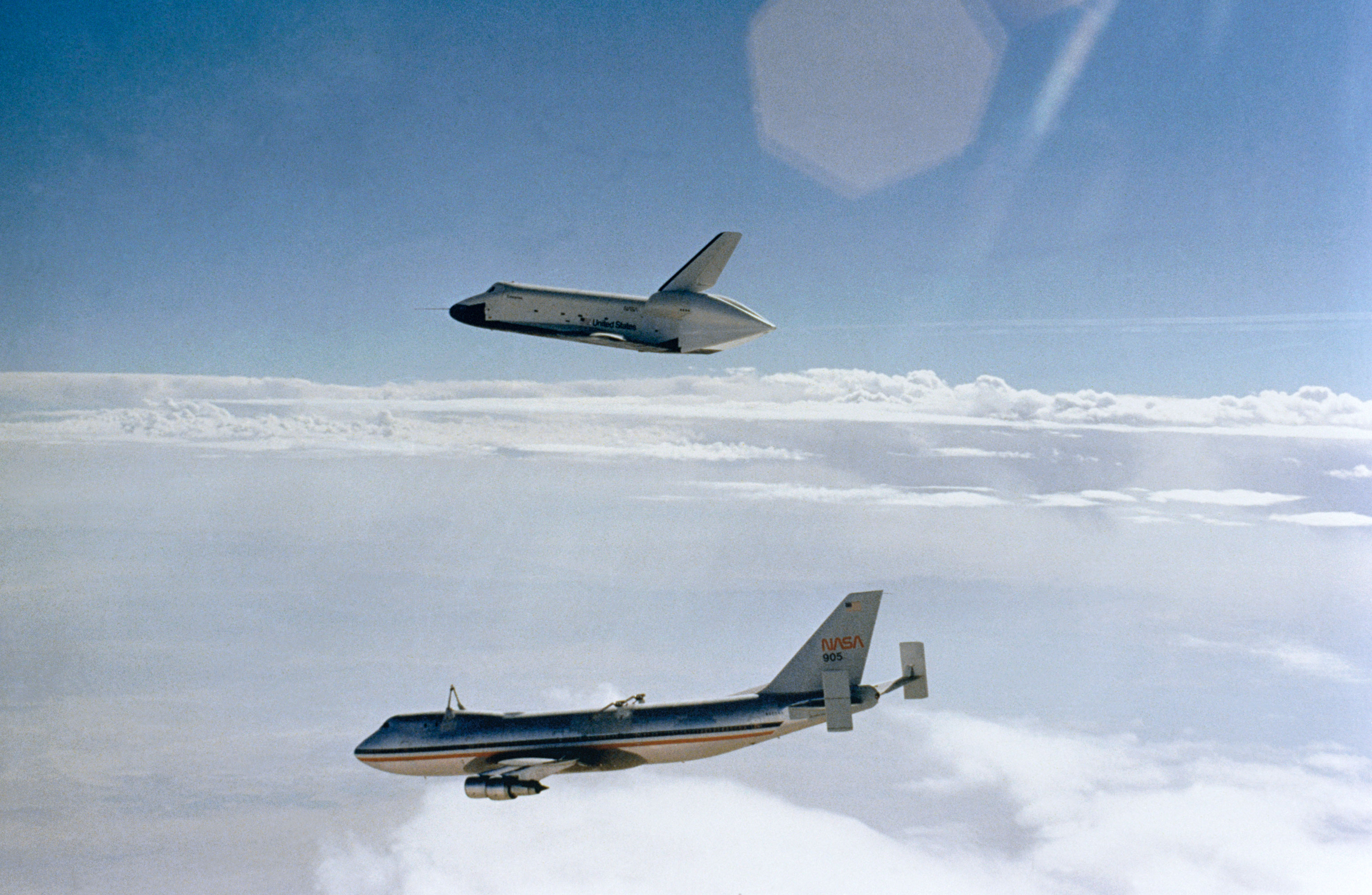
On July 23, 1979, space shuttle Enterprise completed its time as a pathfinder vehicle at Launch Pad 39A at NASA’s Kennedy Space Center (KSC) in Florida. Workers towed it back to the Vehicle Assembly Building (VAB). During its four-month stay at KSC, Enterprise validated procedures for the assembly of the space shuttle stack and interfaces at the launch pad. The tests proved valuable in preparing space shuttle Columbia for its first orbital mission in 1981. Earlier, Enterprise proved the flight worthiness of the shuttle during atmospheric tests and certified the vehicle’s structure to handle launch loads. Later, Enterprise supported the Challenger and Columbia accident investigations. Following a restoration, Enterprise went on public display, first near Washington, D.C., and then in New York City where it currently resides.
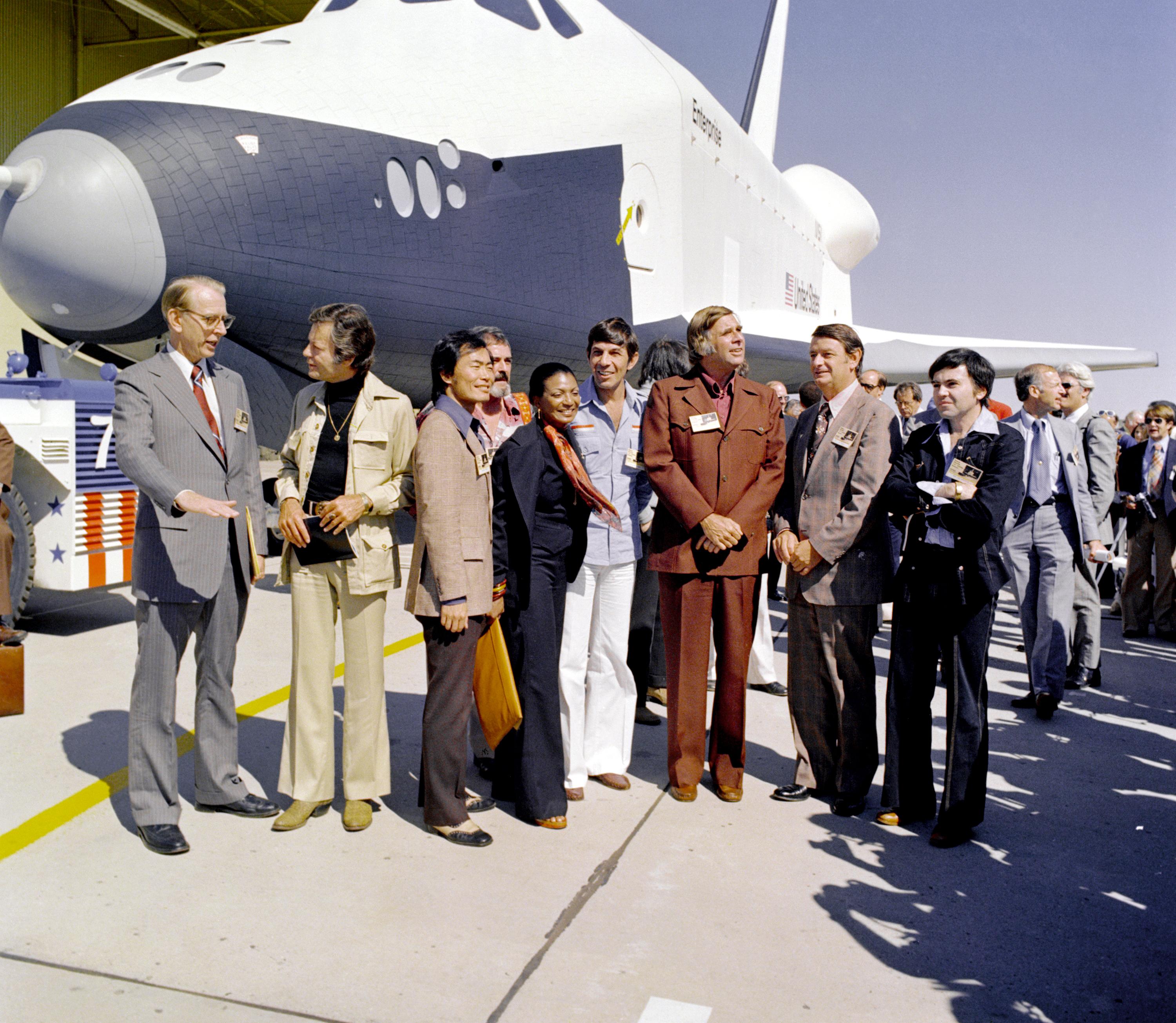


Left: NASA Administrator James C. Fletcher, left, poses with several cast members and creator of the TV series “Star Trek” at Enterprise’s rollout. Middle: Enterprise moments after release from the back of the Shuttle Carrier Aircraft during the first Approach and Landing Test free flight. Right: At NASA’s Marshall Space Flight Center in Huntsville, Alabama, for vibration tests, a shuttle orbiter joins an External Tank and twin Solid Rocket Boosters for the first time.
On Jan. 5, 1972, President Richard M. Nixon directed NASA to build the reusable space shuttle, formally called the Space Transportation System (STS). Manufacture of the first components of Orbital Vehicle-101 (OV-101) at the North American Rockwell Corporation’s plant in Downey, California, began on June 4, 1974. This first vehicle, designed for ground and atmospheric flight tests, received the name Enterprise, following a dedicated write-in campaign by fans of the television science fiction series “Star Trek.” Enterprise rolled out of Rockwell’s Palmdale facility on Sept. 17, 1976. In January 1977, workers trucked Enterprise 36 miles overland from Palmdale to NASA’s Dryden, now Armstrong, Flight Research Center at Edwards Air Force Base (AFB) in California, for the Approach and Landing Tests (ALT), a series of increasingly complex flights to evaluate the shuttle’s air worthiness. At Dryden, workers placed Enterprise on the back of the Shuttle Carrier Aircraft (SCA), a modified Boeing 747. The duo began taxi runs in February, followed by the first captive inactive flight later that month. The first captive active flight with a crew aboard the orbiter took place in June, and Enterprise made its first independent flight on Aug. 12. Four additional approach and landing flights completed the ALT program by October. In March 1978, Enterprise began its first cross-country trip from Edwards to the Redstone Arsenal’s airfield in Huntsville, Alabama. Workers trucked Enterprise to the adjacent NASA Marshall Space Flight Center where engineers for the first time mated it with an External Tank (ET) and inert Solid Rocket Boosters (SRB) in the Dynamic Structural Test Facility. For the next year, engineers conducted a series of vibration tests on the combined vehicle, simulating conditions expected during an actual launch.
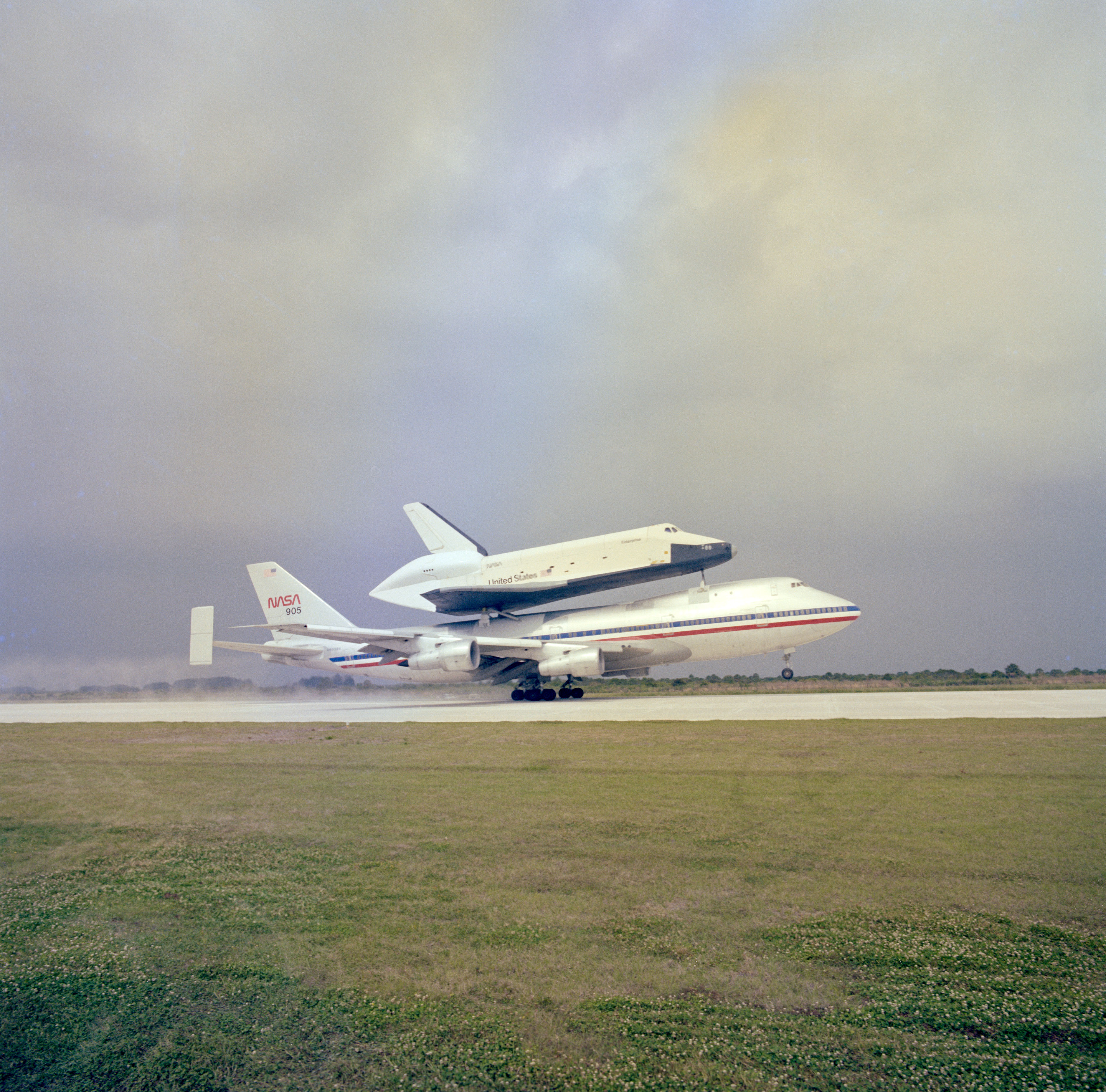
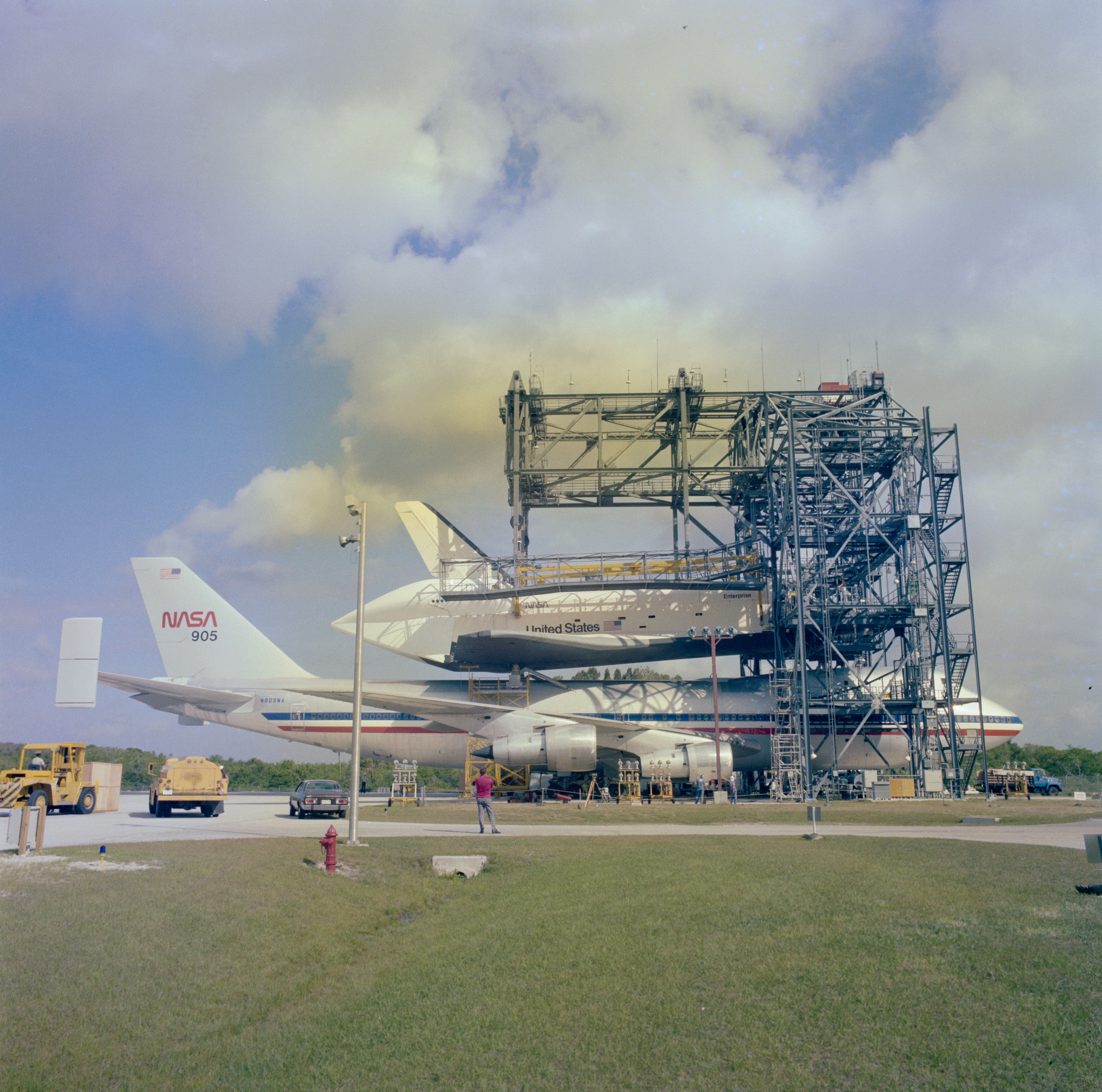

Left: Enterprise atop its Shuttle Carrier Aircraft (SCA) touches down on the runway at NASA’s Kennedy Space Center in Florida. Middle: Workers remove Enterprise from the SCA in the Mate-Demate Device. Right: Workers tow Enterprise into the Vehicle Assembly Building.


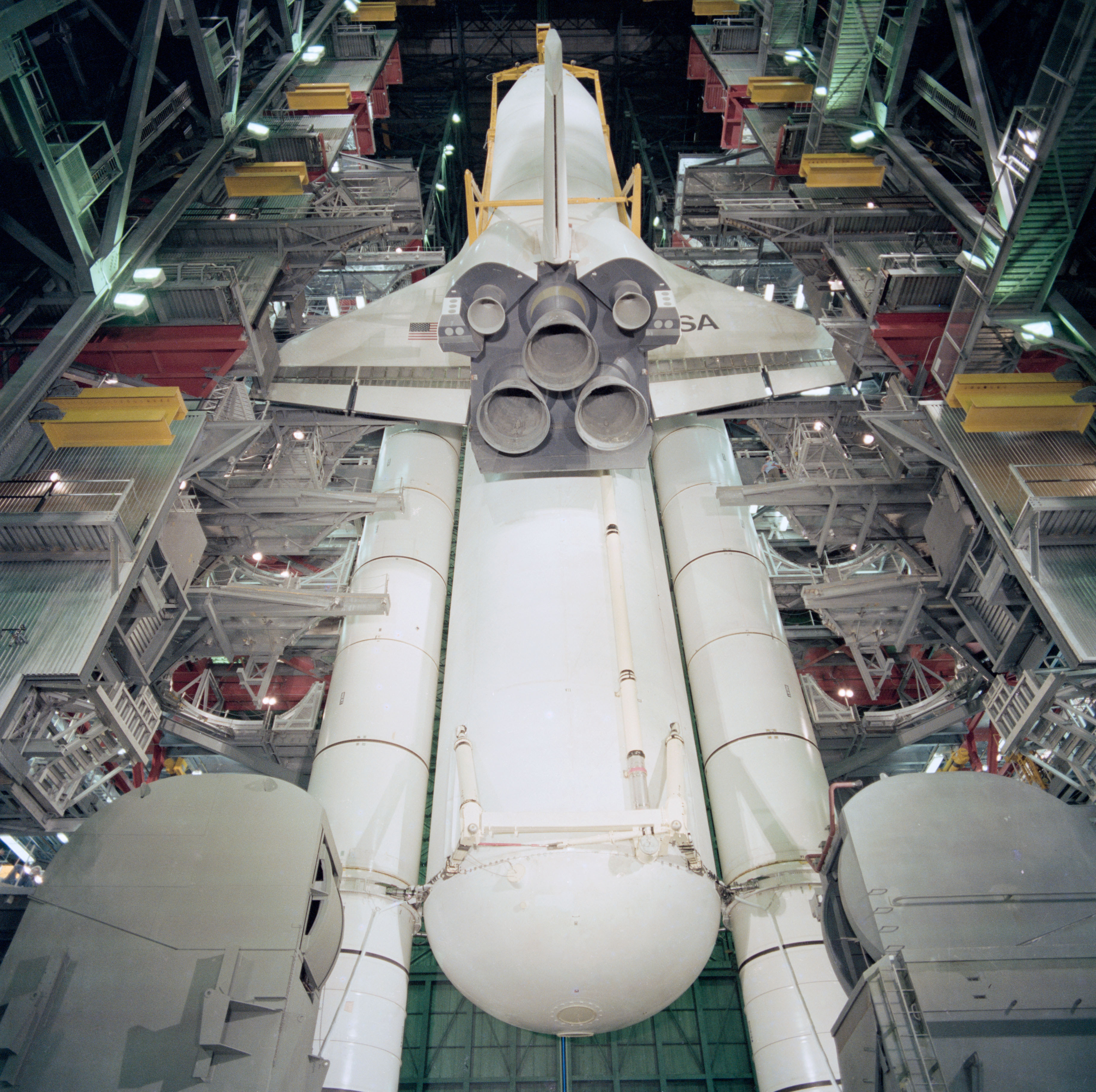
Left: At NASA’s Kennedy Space Center in Florida, workers in the Vehicle Assembly Building prepare to lift Enterprise. Middle: Enterprise in the vertical position. Right: Workers lower Enterprise for attachment to the External Tank and Solid Rocket Boosters.
Following the year-long series of tests at Marshall, on April 10, 1979, NASA ferried Enterprise atop its SCA to KSC. Workers at the SLF removed the orbiter from the back of the SCA in the Mate-Demate Device,and towed it into High Bay 3 of the VAB where on April 25 they completed attaching it to an ET and inert SRBs on a Mobile Launch Platform (MLP) repurposed from carrying Saturn rockets. These activities enabled verification of towing, assembly, and checkout procedures. Since the Apollo and Skylab programs, engineers had made many significant modifications to Launch Pads 39A and 39B to accommodate the space shuttle. Among these included the addition of a fixed launch tower, accommodations for payload handling, and a mobile service structure for access to the vehicle.
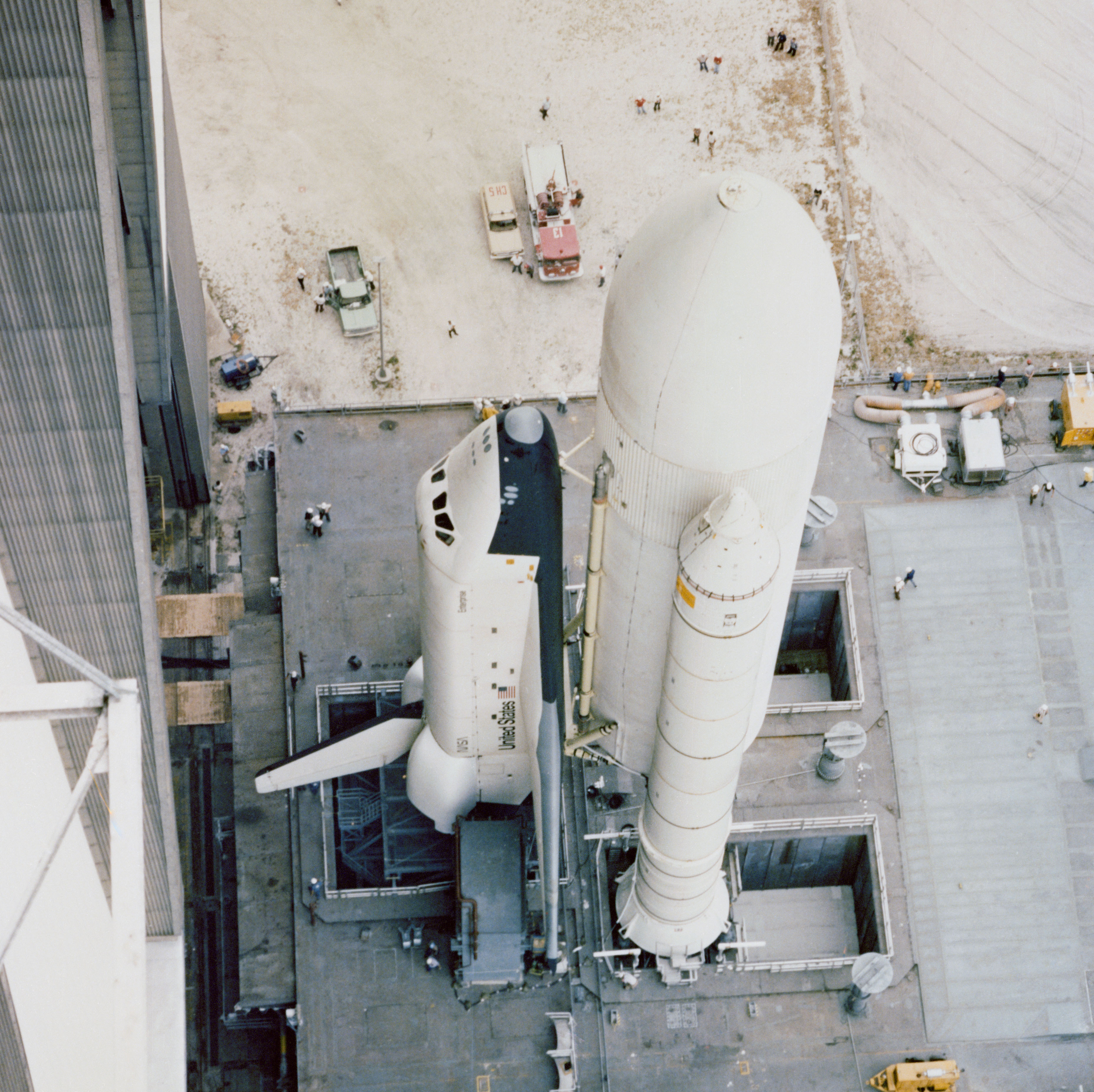


Left: Enterprise exiting the Vehicle Assembly Building at NASA’s Kennedy Space Center in Florida. Middle: Enterprise on its Mobile Launch Platform during the rollout to the pad. Right: Enterprise at Launch Pad 39A.
Rollout of Enterprise from the VAB to Launch Pad 39A occurred on May 1, and its arrival marked the first time that a vehicle stood on that facility since the Skylab 1 space station launch in May 1973. The assembled vehicle including the MLP weighed about 11 million pounds. Technicians drove the stack atop the Crawler Transporter at varying speeds to determine the optimum velocity to minimize vibration stress on the vehicle. The 3.5-mile rollout took about eight hours to complete. Once at the pad, engineers used Enterprise to conduct fit checks and to validate launch pad procedures. During the critical countdown demonstration test, workers filled the ET with super-cold liquid hydrogen and liquid oxygen. The significant discovery that ice built up at the top of the ET during this process led to the addition of the gaseous oxygen vent hood (familiarly known as the “beanie cap”) to the launch pad facility and a procedure to retract it just a few minutes before liftoff. This prevented the dangerous buildup of ice during the countdown and ranks as perhaps one of Enterprise’s greatest contributions as a test vehicle during its time at the launch pad.

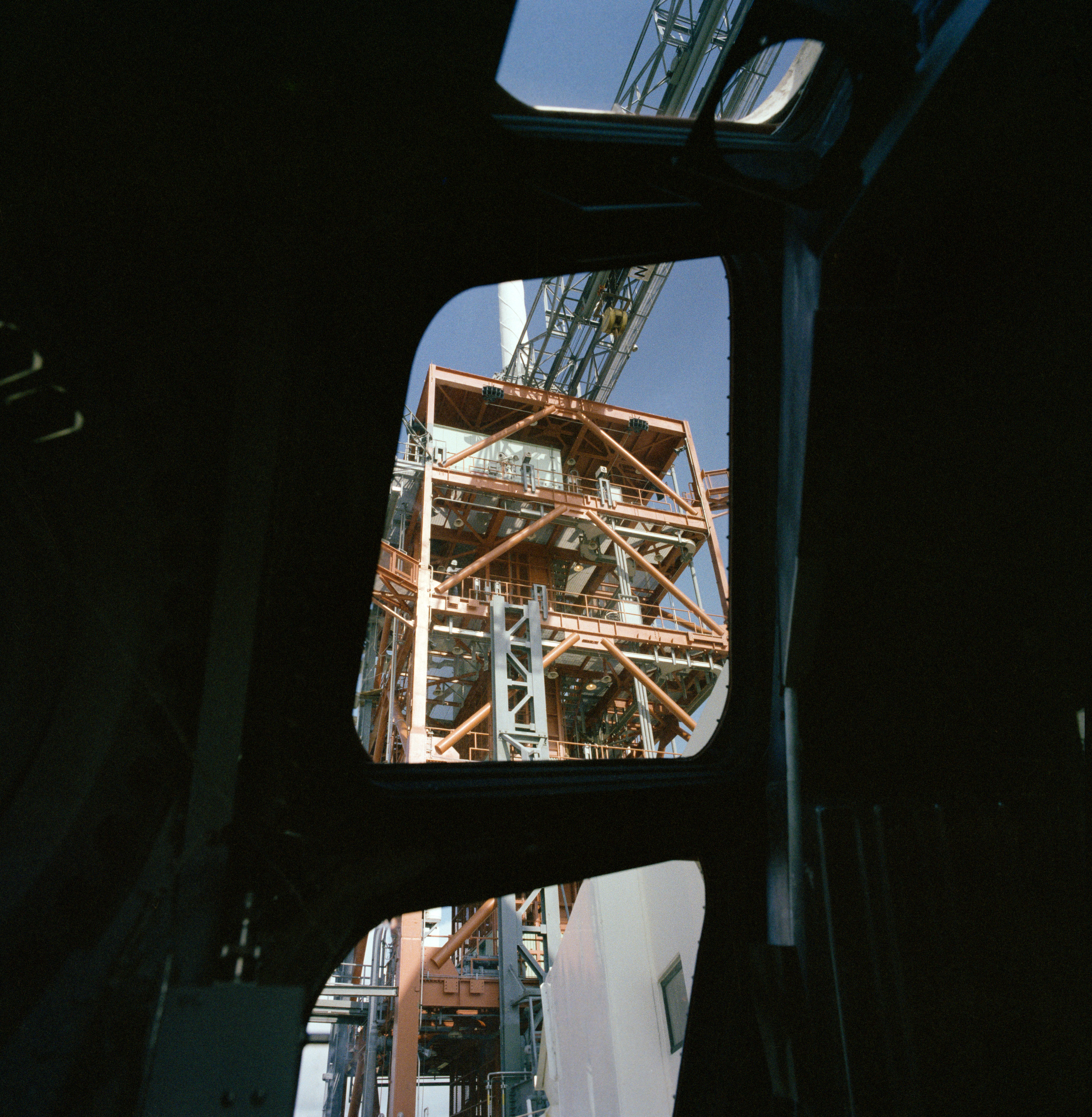

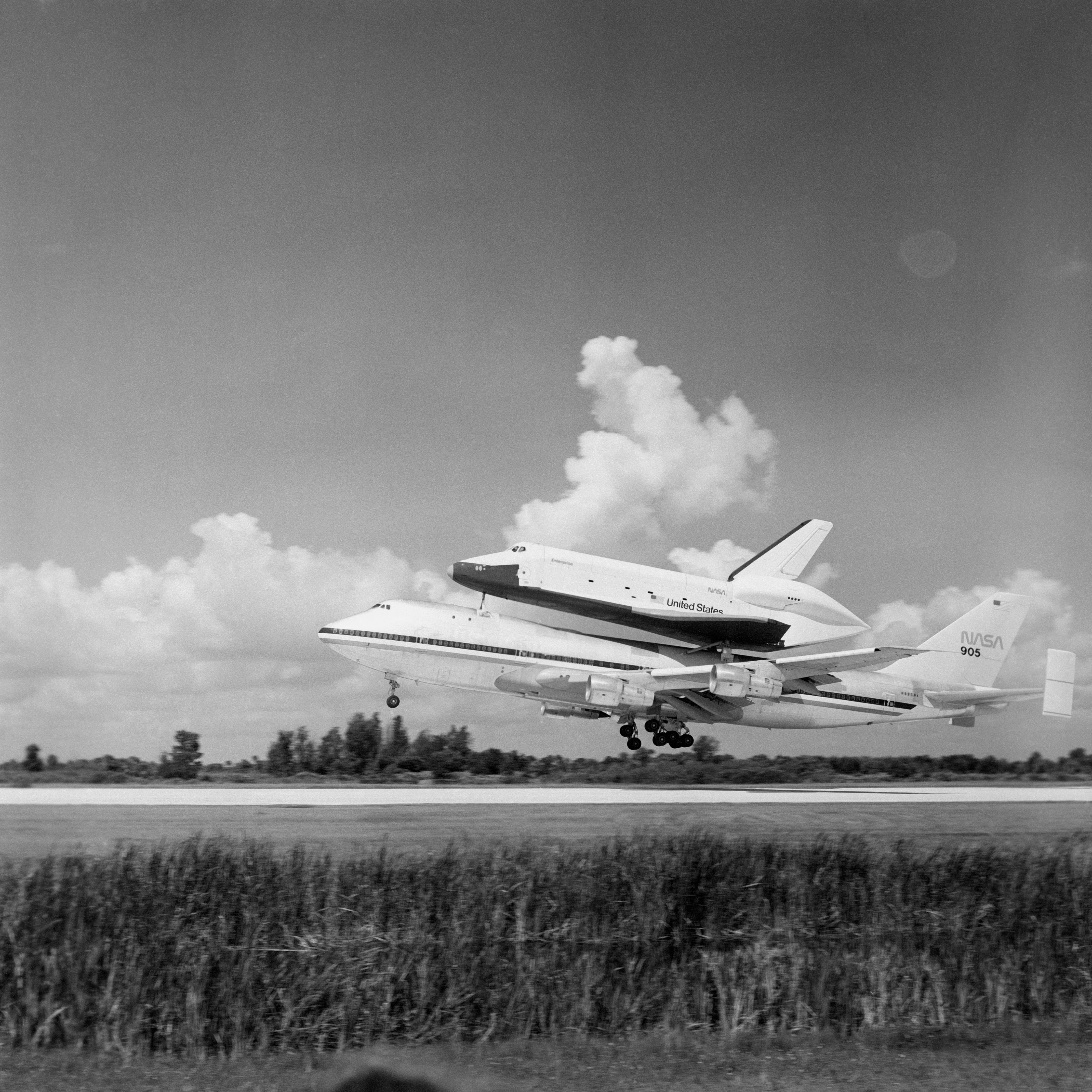
Left: Engineer Richard W. Nygren poses in front of Enterprise at Launch Pad 39A with astronauts Richard H. Truly, John W. Young, Robert L. Crippen, and Joe H. Engle, the prime and backup crews assigned to STS-1, the first space shuttle mission. Middle left: Pilot’s eye view of the launch tower looking up through Enterprise’s forward windows. Middle right: Enterprise rolls back into the Vehicle Assembly Building. Right: Enterprise departs NASA’s Kennedy Space Center in Florida atop the Shuttle Carrier Aircraft.
On July 23, after three months of fit checks and testing, workers rolled Enterprise back from Launch Pad 39A to the VAB’s High Bay 1. The activities conducted at the pad proved instrumental in paving the way for its sister ship Columbia to make its first launch in 1981. John Bell, who managed the activities at KSC said of the test program, “Overall, it was a very successful venture and well worth it.” Launch Pad 39A Site Manager John J. “Tip” Talone added, “Having [Enterprise] out here really saved the program a lot of time in getting things ready for [Columbia].” In the VAB, workers removed Enterprise from its ET on July 25 and towed it to the SLF on Aug. 3 where it awaited the arrival of the SCA. The ferry flight back to Dryden took place Aug. 10-16, making six stops along the way – Atlanta, St. Louis, Tulsa, Denver, Salt Lake City, and Vandenberg AFB in California. Up to 750,000 people came out to see the orbiter and SCA. Back at Dryden, workers demated Enterprise and on Oct. 30 trucked it back to the Palmdale plant where engineers removed computers and instruments to be refurbished and used in other orbiters then under construction. Previous plans to convert Enterprise into an orbital vehicle proved too costly and NASA abandoned the idea.
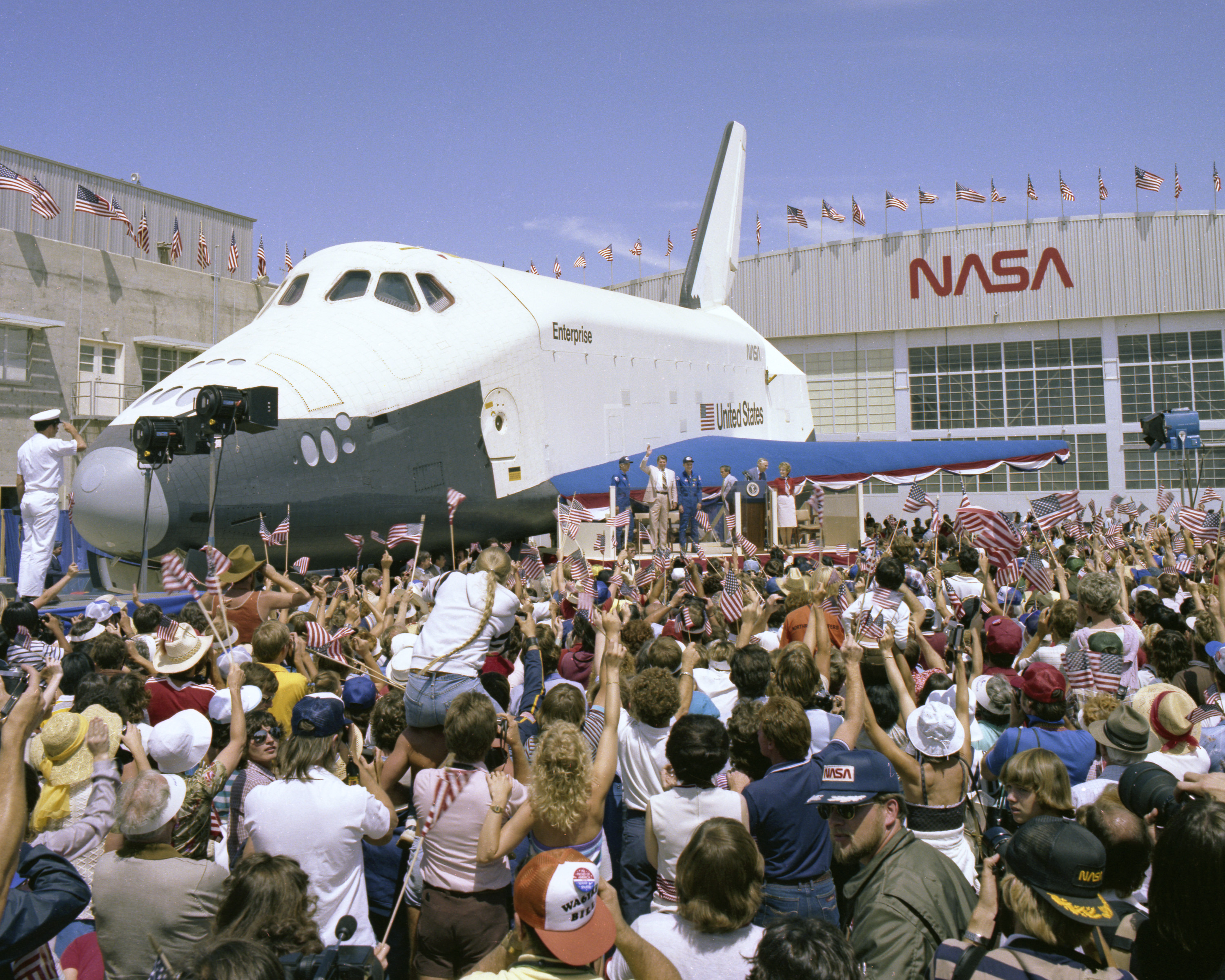
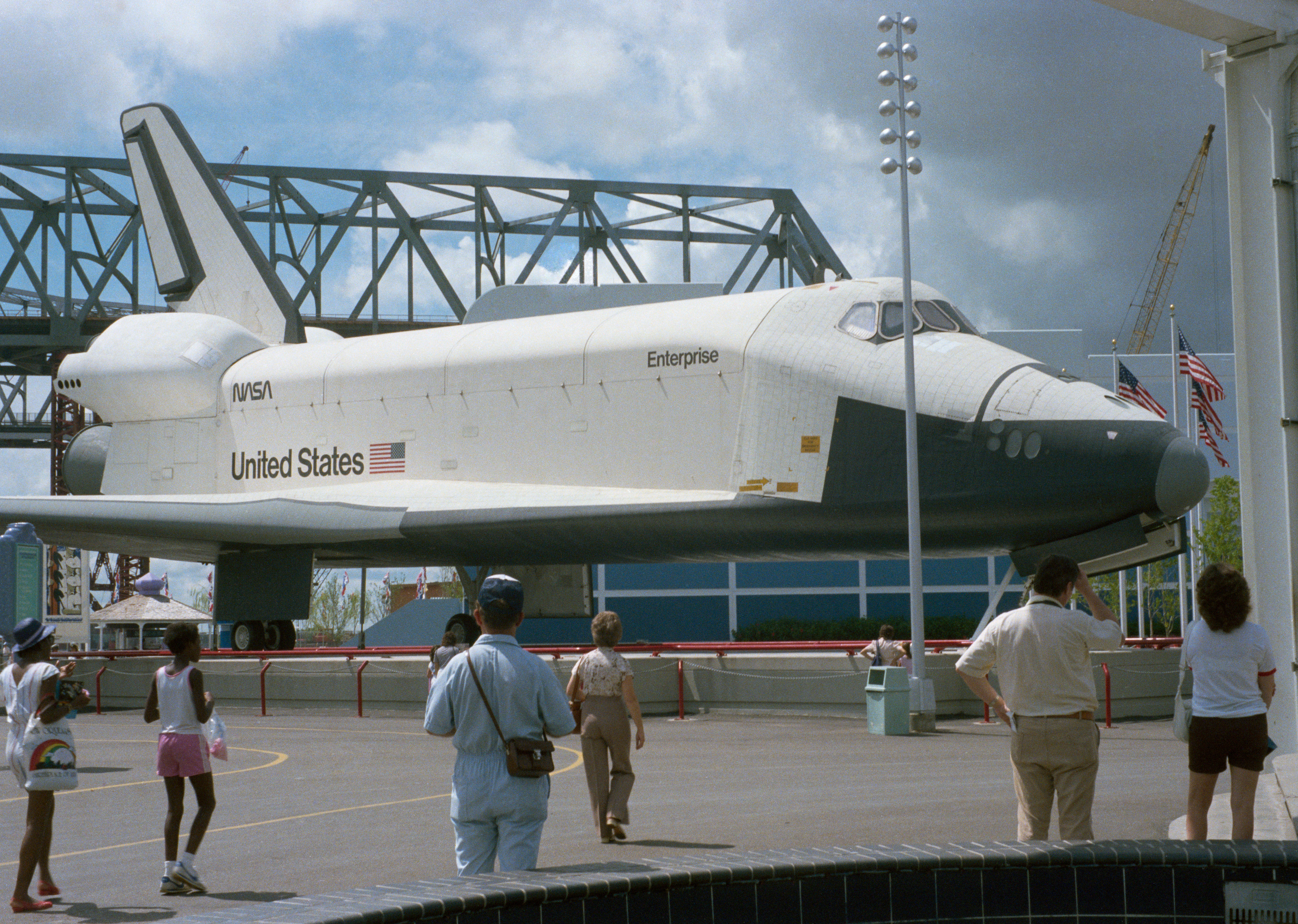

Left: Enterprise as the backdrop for President Ronald W. Reagan welcomes home the STS-4 crew at NASA’s Dryden, now Armstrong, Flight Research Center in July 1982. Middle: Enterprise on display at the World’s Fair in New Orleans in 1984. Right: Enterprise during static pad tests at Space Launch Complex-6 at Vandenberg Air Force, now Space Force, Base in 1985.
With its major pathfinder tasks completed, and its future uncertain, NASA returned Enterprise to Dryden on Sep. 6, 1981, for long-term storage. On July 4, 1982, NASA used it as a backdrop for President Ronald W. Reagan to welcome home the STS-4 crew. The following year, NASA sent Enterprise on a European tour, departing Dryden on May 13, 1983, with stops in the United Kingdom, Germany, Italy, and France for the annual Paris Air Show. Enterprise made a stop in Ottawa, Canada, on its return trip to Dryden, arriving there June 13. Workers once again placed it in temporary storage. For its next public appearance, NASA placed it on display in the U.S. pavilion of the World’s Fair in New Orleans between April and November 1984. After the World’s Fair, NASA ferried Enterprise to Vandenberg AFB in California to conduct fit checks at the Space Launch Complex-6 (SLC-6), that NASA had planned to use for polar orbiting shuttle missions. NASA used Enterprise to conduct tests at SLC-6 similar to the 1979 tests at KSC’s Launch Complex 39. The tests at Vandenberg completed, NASA ferried Enterprise back to Dryden on May 24, 1985, but this time for only a short-term storage. On Sep. 20, 1985, NASA ferried Enterprise to KSC and placed it on temporary public display near the VAB, next to the Saturn V already displayed there. After two months on display at KSC, NASA flew Enterprise to Dulles International Airport in Chantilly, Virginia, arriving on Nov. 18. NASA officially retired Enterprise and transferred ownership to the Smithsonian Institution that had plans to build a large aircraft museum annex at the airport. The Smithsonian placed Enterprise in storage in a hangar, awaiting the completion of its new home. That turned into an 18-year wait.

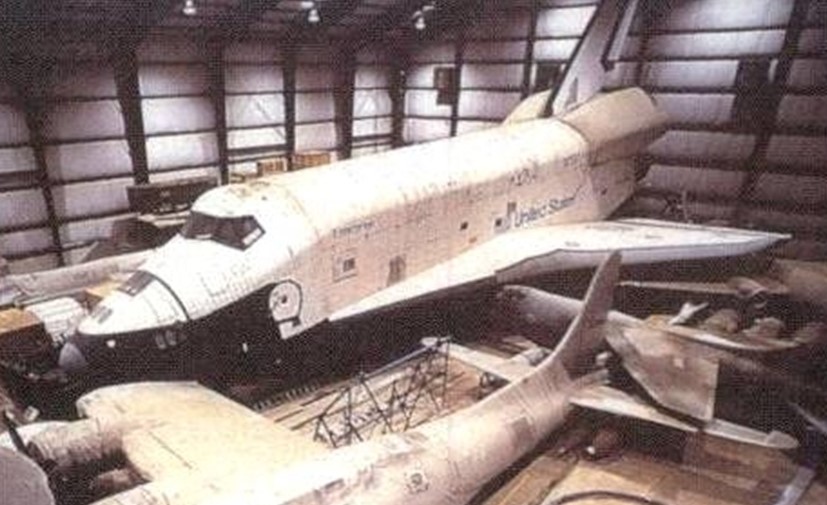
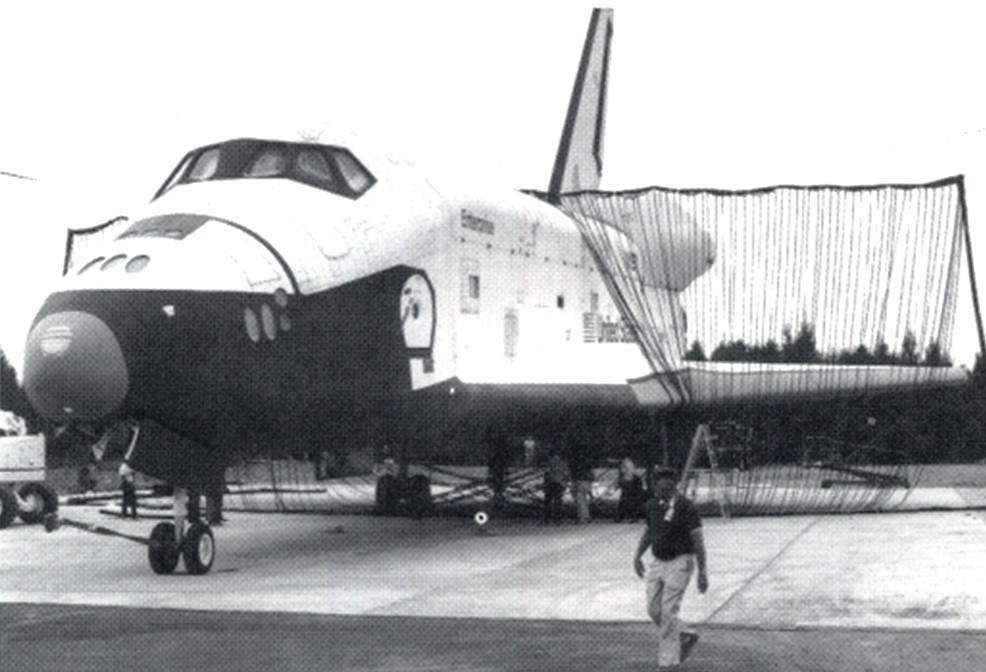
Left: Launch of STS-61A in October 1985, with Enterprise and the Saturn V in the foreground. Middle: Enterprise in long-term storage at Dulles International Airport in Chantilly, Virginia. Right: Enterprise during arresting barrier testing at Dulles.
But even during that 18-year wait, NASA found practical use for the venerable Enterprise. In 1987, the agency studied how to handle an orbiter returning from space should it suffer a brake failure. To test the efficacy of an arresting barrier, workers at Dulles slowly winched Enterprise into a landing barrier to see if the vehicle suffered any damage. Later that same year, NASA used Enterprise to test various crew bailout procedures being developed in the wake of the Challenger accident. In 1990, experimenters used Enterprise’s cockpit windows to test mount an antenna for the Shuttle Amateur Radio Experiment, with no other orbiters available. Periodically, engineers removed parts from Enterprise to test for materials durability, and evaluated the structural integrity of the vehicle including its payload bay doors and found it to be in sound condition even after years in storage. In April 2003, in the wake of the Columbia accident, investigators borrowed Enterprise’s left landing gear door and part of the port wing for foam impact tests. The tests provided solid evidence for the foam strike as the cause of the accident.
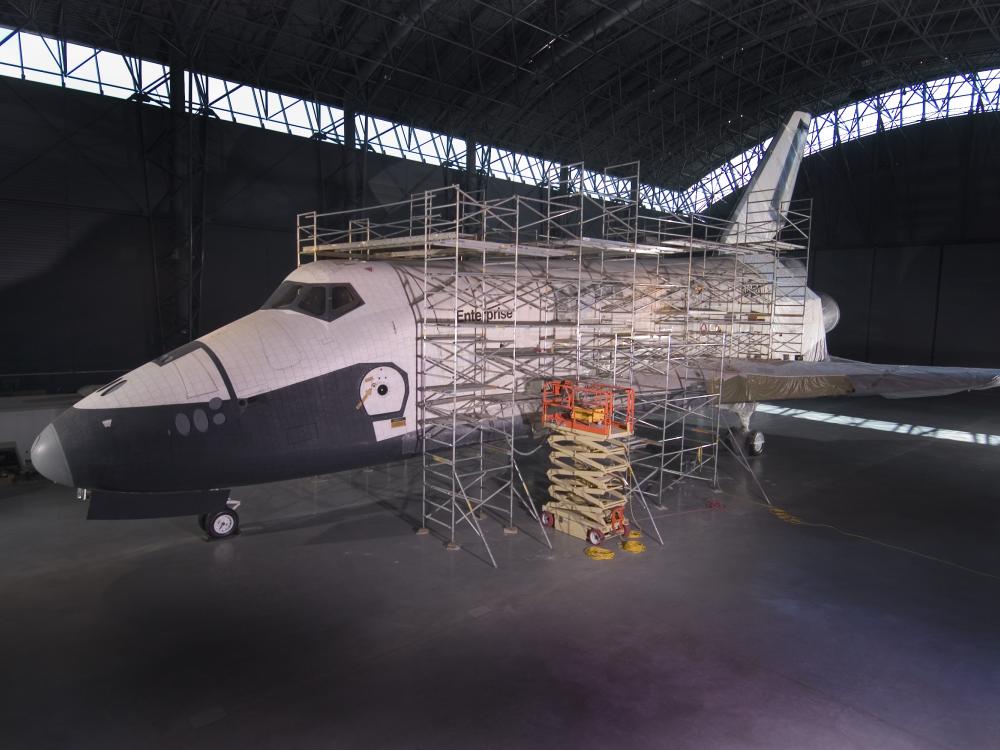

Left: Space shuttle Enterprise undergoes restoration at the Stephen F. Udvar-Hazy Center of the Smithsonian Institution’s National Air and Space Museum (NASM) in Chantilly, Virginia. Note the missing wing leading edge, donated for the Columbia accident investigation. Right: Enterprise on display at the Hazy Center. Image credits: courtesy NASM.
On Nov. 20, 2003, workers towed Enterprise from its storage facility into a newly completed display hangar at the Stephen F. Udvar-Hazy Center of the Smithsonian Institution’s National Air and Space Museum at Dulles. After specialists spent eight months restoring the orbiter, the museum placed it on public display on Dec. 15, 2004.
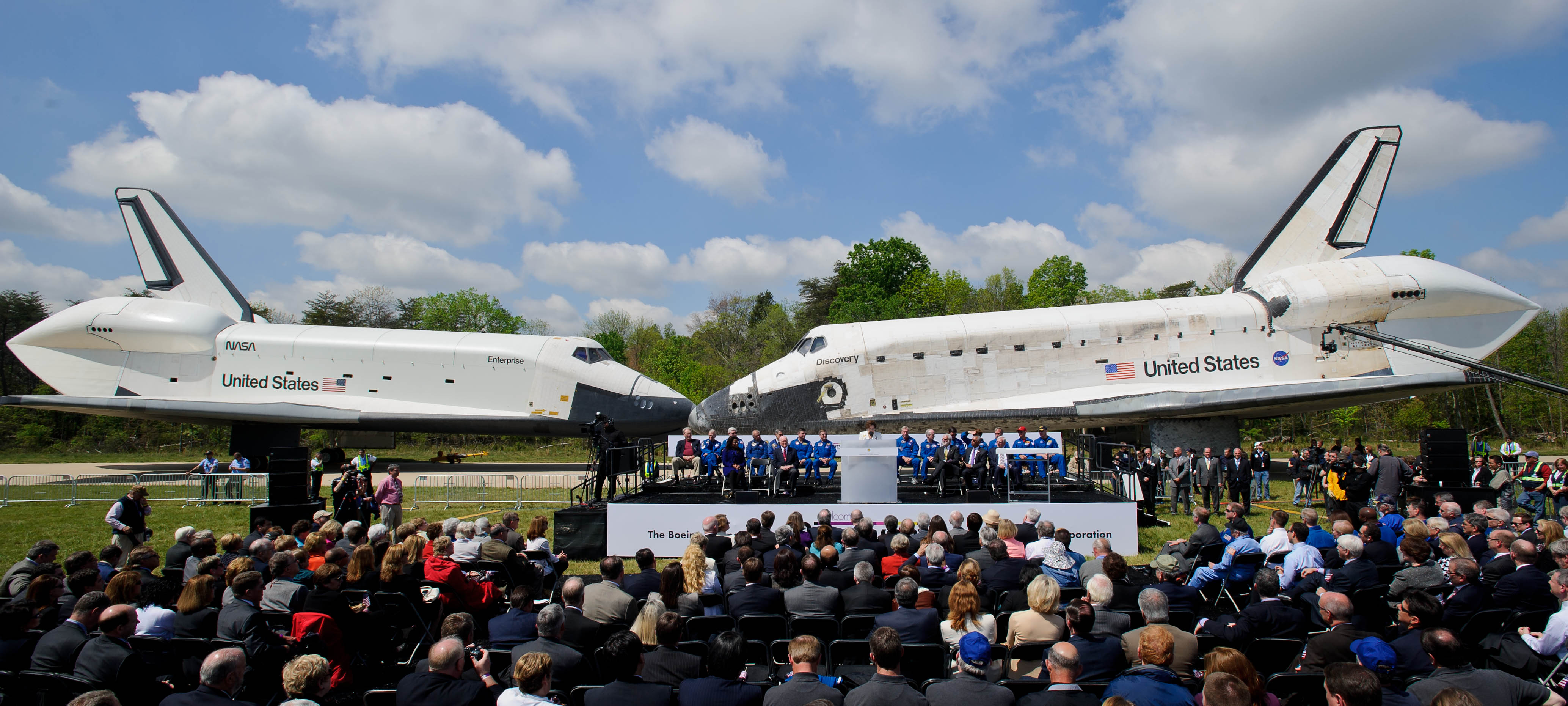
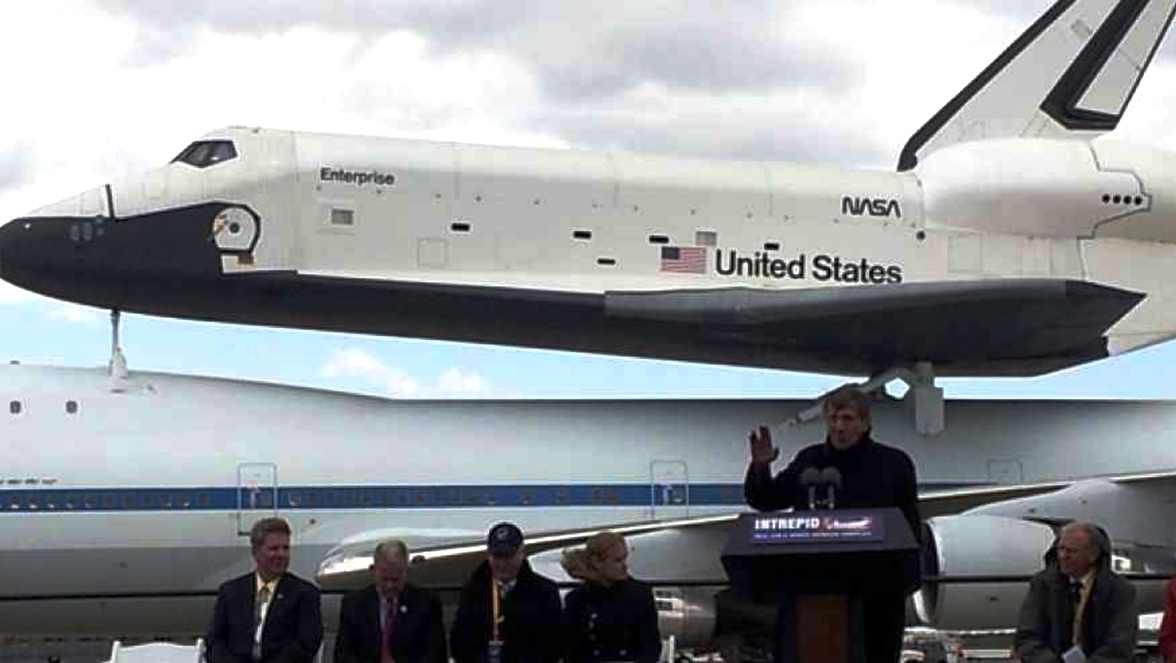
Left: Space shuttle orbiters Enterprise, left, and Discovery meet nose-to-nose at the Stephen F. Udvar-Hazy Center of the Smithsonian Institution’s National Air and Space Museum in Chantilly, Virginia. Right: Actor Leonard Nimoy greets Enterprise at New York’s John F. Kennedy International Airport.
In 2011, NASA retired the space shuttle fleet and donated the vehicles to various museums around the country. The Intrepid Sea, Air & Space Museum in New York City acquired Enterprise, and on Apr. 19, 2012, workers removed the orbiter from its display at the Hazy Center – replacing it with the orbiter Discovery – and placed it atop a SCA for the final time. Eight days later, after a short flight from Dulles, Enterprise landed at John F. Kennedy International Airport. Workers lifted the orbiter from the SCA and placed it on a barge. It eventually arrived at the Intrepid Museum on June 3 and went on public display July 19. Enterprise suffered minor damage during Superstorm Sandy in October 2012, but workers fully restored it.

Enterprise in the Shuttle Pavilion at the Intrepid Sea, Air & Space Museum in New York City. Image credit: courtesy Intrepid Museum.
What's Your Reaction?



















.jpg?#)




















